Did you know that cardoon, also known as the thistle vegetable, is not just a decorative plant but also an edible delight? This unique vegetable, with its spiny leaves and non-edible flower head, is a close relative of the globe artichoke. The stalks of the cardoon plant, harvested like celery, offer a rich and flavorful treat for those adventurous enough to try it.
Key Takeaways:
- Cardoon is an edible thistle vegetable that is a close relative of the globe artichoke.
- The stalks of the cardoon plant are harvested like celery and have a rich, flavorful taste.
- The leaves of the cardoon plant are bitter and should be removed before consumption.
- Cardoon plants thrive in cool to warm growing conditions, preferring a mild, damp, maritime climate.
- Cardoon plants need full sun, moderate watering, and well-draining, fertile soil to grow successfully.
Basics of Growing Cardoon
Growing cardoon is a rewarding and relatively easy endeavor, whether you choose to cultivate it as a perennial or an annual plant. The adaptability of cardoon allows it to flourish in various climates. In cooler weather, cardoon plants are grown as annuals, while in warmer regions, they can be grown as perennials. To successfully grow cardoon, it’s important to understand its basic requirements and care needs.
Cardoon plants thrive best in a mild and damp climate with a maritime influence. They require an ample amount of sunlight to grow and should be placed in a location that receives full sun exposure. Before planting cardoon, it’s crucial to ensure that all frost danger has passed and the soil has warmed up to at least 55°F. Cardoons are frost-tender plants, and planting them too early can result in damage to the delicate foliage.
Starting cardoon plants indoors and then transplanting them to the outdoor garden can give them a head start in the growing season. This method allows for better control of seed germination and early growth. When starting cardoon seeds indoors, it’s important to use a well-draining seed starting mix and provide adequate moisture to promote germination. Transplant the young seedlings to the garden when they have developed a few sets of true leaves.
Cardoon plants have moderate water needs and prefer a consistent and moderate watering regime. Although they are relatively drought-tolerant, it’s important to ensure that the plants receive enough moisture to support healthy growth. As the plants grow, it’s important to monitor the soil moisture levels and water accordingly. Overwatering can lead to root rot, so it’s crucial to maintain a balance in watering practices.
Feeding cardoon plants with compost or aged manure annually can provide them with the necessary nutrients for optimal growth and development. Additionally, occasional foliar feeds of compost tea or liquid kelp can further enhance the plant’s vitality. These natural fertilizers provide a rich source of organic matter and essential nutrients, promoting lush growth and improving overall plant health.
Cardoons are vigorous plants that require ample space to grow. They are not suitable for small gardens due to their large size and expansive foliage. However, if space is limited, cardoon plants can be grown in containers with adequate dimensions and proper care. Container-grown cardoons require regular watering and feeding to maintain healthy growth.
| Basics of Growing Cardoon | |
|---|---|
| Plant Type | Perennial or annual |
| Climate | Mild, damp, maritime |
| Sunlight | Full sun |
| Temperature | Avoid planting until soil reaches at least 55°F |
| Watering | Moderate water needs, relatively drought-tolerant |
| Fertilization | Compost or aged manure annually, occasional foliar feeds with compost tea or liquid kelp |
| Space Requirements | Require lots of space, not suitable for small gardens |
With proper attention to their basic needs, cardoon plants can thrive in gardens, providing not only aesthetic beauty but also a delicious and unique vegetable. Whether you have a spacious garden or opt for container gardening, growing cardoon can be a delightful and rewarding experience.
Soil Preparation for Cardoon Planting
Proper soil preparation is essential for the healthy growth of cardoon plants. Cardoons prefer well-draining, fertile soil and are adaptable to various soil types. However, they perform best in soil that is rich in organic matter.
To prepare the soil for cardoon planting, it’s important to amend the planting area with compost or well-rotted manure. This will help enrich the soil and provide the necessary nutrients for the plants to thrive. If the soil in your garden is heavy clay, incorporating some sand or gravel can improve drainage and prevent waterlogging.
Remember, cardoons prefer a well-draining environment, so it’s crucial to ensure proper drainage in the planting area. Amending the soil with organic matter and improving the drainage will create the ideal growing conditions for cardoon plants.
Tip: If you’re unsure about the quality of your soil, consider conducting a soil test to determine its pH levels and nutrient content. This will help you make any necessary adjustments to optimize the soil for cardoon cultivation.
So, before you start planting your cardoon seeds or transplants, take the time to prepare the soil properly. Your cardoon plants will thank you with healthy growth and abundant harvests!
| Benefits of Soil Preparation for Cardoon Planting | Steps for Soil Preparation |
|---|---|
|
|
Planting Cardoon
When it comes to planting cardoon, there are a few key factors to consider. Proper spacing, seed depth, watering, and fertilization are essential for the successful growth of cardoon plants.
Plant Spacing
To allow ample room for growth, cardoon plants should be spaced approximately 24-36 inches apart. This spacing ensures that each plant has enough space to develop to its full potential.
Seed Depth
When sowing cardoon seeds, it’s important to plant them shallowly, at a depth of about 1/4 inch. This ensures that the seeds have the right conditions to germinate and sprout.
Watering
Cardoon plants require consistent moisture to thrive, but it’s important not to overwater them. After planting, thoroughly water the soil around the plants, and maintain a moist but not waterlogged environment.
Fertilization
At the beginning of the growing season, applying a balanced, slow-release fertilizer can provide the necessary nutrients for healthy cardoon growth. This helps promote strong stalks and robust foliage.
Staking
Some varieties of cardoon, especially in windy locations or when large flower heads develop, may require staking to prevent them from flopping over. Stakes can provide support and maintain the plant’s upright position.
Pruning
Regular pruning is essential to prevent excessive self-seeding and to maintain the shape of the cardoon plant. Remove spent flower heads to encourage continued growth and prevent the plant from diverting energy into seed production.
Following these planting guidelines will set your cardoon plants on the path to success, ensuring healthy growth and a bountiful harvest.
Cardoon Plant Care
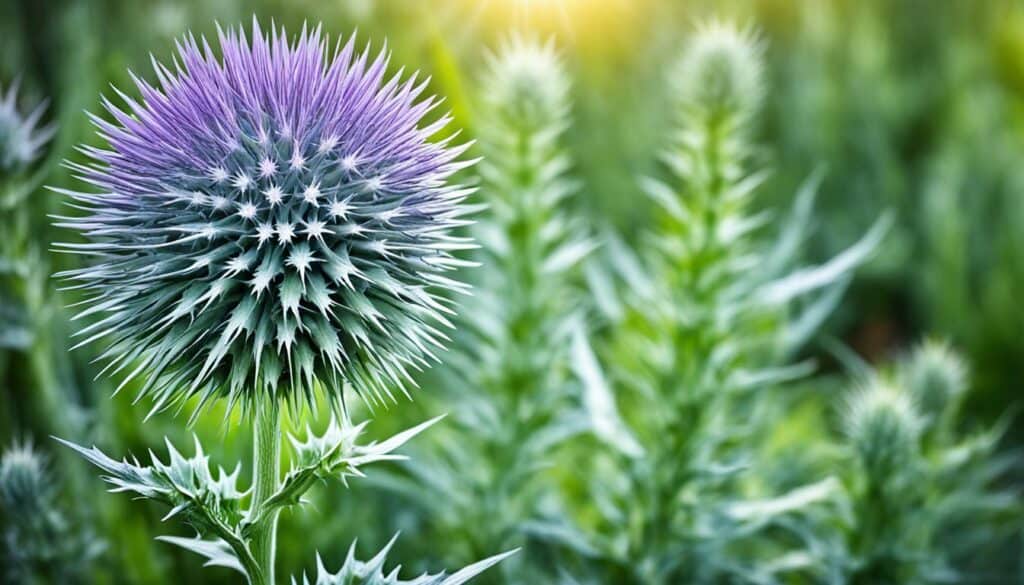
To ensure the healthy growth of your cardoon plants, proper care and attention are crucial. By following these cardoon plant care tips, you’ll be able to maintain vibrant and thriving plants.
1. Mulching for Moisture Control
Applying mulch around the base of your cardoon plants offers multiple benefits. It helps retain soil moisture, suppresses weeds, and regulates soil temperature. Use organic mulch, such as straw or shredded bark, to create a protective layer around the plants.
2. Providing Adequate Moisture
Cardoons require a uniform supply of moisture to prevent leaf and stalk pithiness. Aim to provide 10-12 inches of water throughout the growing period, evenly distributed. Regularly check the soil moisture levels and water when necessary. Avoid overwatering, which can lead to root rot.
3 Controlling Pests
Monitor your cardoon plants for common pests like slugs and snails. These pests can damage the foliage and hinder plant growth. If you notice any signs of pest infestation, take appropriate measures to control them. Organic pest control methods, such as handpicking or using natural predators, can be effective.
4. Protecting in Cold Climates
In colder climates, where frost may damage your cardoon plants, it’s important to take precautions. Before the onset of winter, protect the crown of the plant by applying a thick layer of mulch. This layer acts as insulation, helping the plants overwinter successfully.
By implementing these cardoon plant care practices, you can enjoy the beauty and harvest of these unique plants. Keep an eye on soil moisture, control pests, and provide the necessary protection in colder climates to ensure the best results.
Harvesting Cardoon
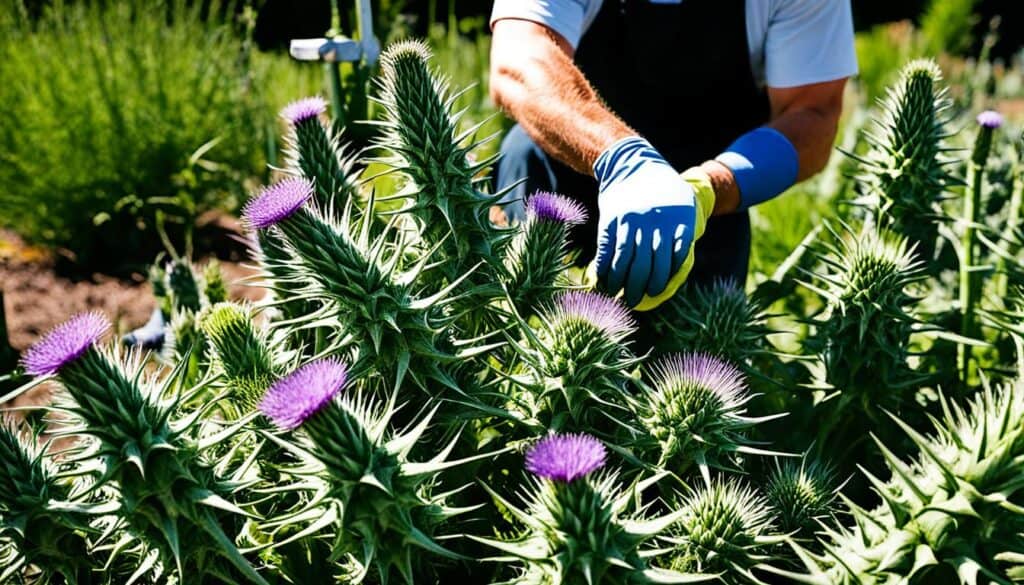
After patiently caring for your cardoon plants, it’s time to reap the rewards of your hard work. Harvesting cardoon typically begins approximately 120 to 150 days after planting. To ensure the best flavor and texture, it’s important to harvest the plants at the right time.
Understanding Maturity
As the leaves of the cardoon plant near maturity, you’ll notice their robust size and rich color. At this stage, it’s crucial to blanch the leaf stalks to enhance their tenderness and flavor. Blanching involves tying the leaves together near the top and wrapping the plants in burlap or another suitable material. This process typically takes about 4-5 weeks.
The Harvesting Process
When the blanching period is complete, the blanched plant parts are ready to be carefully harvested. Begin by cutting the blanched stalks just below the crown, leaving behind excess loose leaves. Trimming the stalks will reveal the trimmed, blanched heart, which is the prized edible part of the cardoon plant.
The harvested cardoon hearts are best consumed fresh to savor their unique taste and texture. While they can be stored for a short period, it is generally recommended to enjoy them promptly for optimal freshness and flavor.
| Harvesting Tips for Cardoon |
|---|
| Harvest cardoon plants 120 to 150 days after planting. |
| Blanch the leaf stalks by tying them together and wrapping them in burlap or a similar material for 4-5 weeks. |
| Cut the blanched stalks just below the crown, removing excess loose leaves. |
| Enjoy the fresh cardoon hearts promptly for optimal flavor and texture. |
Note: Harvesting practices may vary slightly depending on your specific cardoon variety and personal preferences. Always refer to specific guidelines for the best results.
Harvesting mature cardoon plants yields delicious and flavorful edible hearts.
Winter Care for Cardoon
In colder climates, where cardoon plants may not survive the winter, it’s important to take appropriate winter care measures. Applying a thick layer of mulch to protect the crown of the plant can help it overwinter. The mulch acts as insulation and helps prevent frost damage. It’s recommended to use a temperature of 32°F and a relative humidity of 95 to 100% to prevent wilting or drying during the winter months.
Winter Care Tips for Cardoon Plant
- Apply a thick layer of mulch around the base of the cardoon plant to protect the crown.
- The mulch will act as insulation against frost and maintain a stable soil temperature.
- Use a temperature of 32°F and a relative humidity of 95 to 100% to prevent wilting or drying during the winter.
- Ensure the mulch is spread evenly and covers the entire base of the plant.
- Monitor the moisture levels regularly and water as needed to keep the soil moist but not waterlogged.
- Inspect the cardoon plant regularly during the winter months for any signs of damage or disease.
By providing adequate protection and care during the winter months, you can ensure the survival and health of your cardoon plants even in colder climates.
| Winter Care for Cardoon | Tips |
|---|---|
| Apply a thick layer of mulch | Protects the crown of the plant |
| Use a temperature of 32°F | Prevents wilting or drying |
| Maintain a relative humidity of 95 to 100% | Ensures the plant’s health during winter |
Unique Benefits and Uses of Cardoon
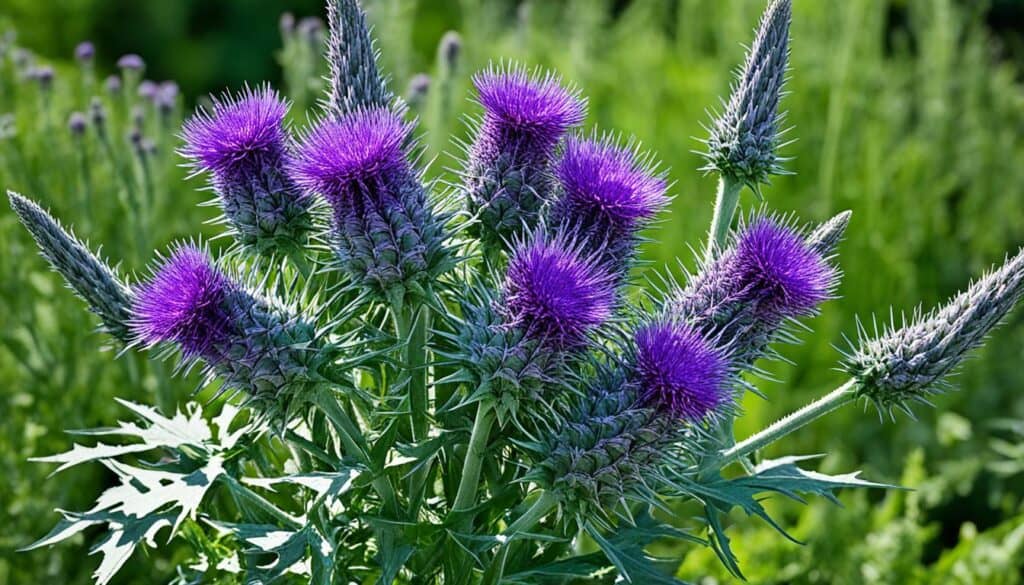
In addition to being a unique vegetable with a rich flavor, cardoon offers various benefits and uses. The young, tender leaf mid-ribs and immature flower stalks of the cardoon plant are edible and can be incorporated in a variety of recipes. Whether baked, stewed, or sautéed, cardoon adds a distinct flavor to Mediterranean dishes.
Blanching the cardoon hearts, similar to celery stalks, is a popular method of preparation. This technique helps reduce the bitterness and enhances the delicate flavor of the stalks. The result is a tender and flavorful addition to salads, soups, or side dishes.
Cardoon recipes often highlight the plant’s unique flavor profile and versatility. From classic dishes to contemporary creations, cardoon can be a delightful ingredient in both traditional and innovative culinary creations.
Health Benefits of Cardoon
Aside from its culinary uses, cardoon also offers notable health benefits. It is a good source of fiber, providing essential nourishment for a healthy digestive system. The high fiber content supports regular bowel movements and contributes to overall digestive well-being.
Cardoon is also rich in vitamins and minerals that are essential for maintaining optimal health. It contains antioxidants, which help protect the body against free radicals, potentially reducing the risk of chronic diseases.
Furthermore, cardoon has been associated with potential anti-inflammatory properties, making it a valuable addition to an anti-inflammatory diet. Including cardoon in your meals can contribute to a balanced and nutritious eating plan.
| Nutrient | Amount per 100g |
|---|---|
| Calories (kcal) | 17 |
| Protein (g) | 1.4 |
| Fat (g) | 0.2 |
| Carbohydrates (g) | 3.8 |
| Fiber (g) | 1.6 |
| Vitamin C (mg) | 2.7 |
| Vitamin K (µg) | 10.1 |
| Potassium (mg) | 246 |
| Magnesium (mg) | 18 |
| Phosphorus (mg) | 36 |
Table: Cardoon Nutritional Information per 100g
Varieties of Cardoon
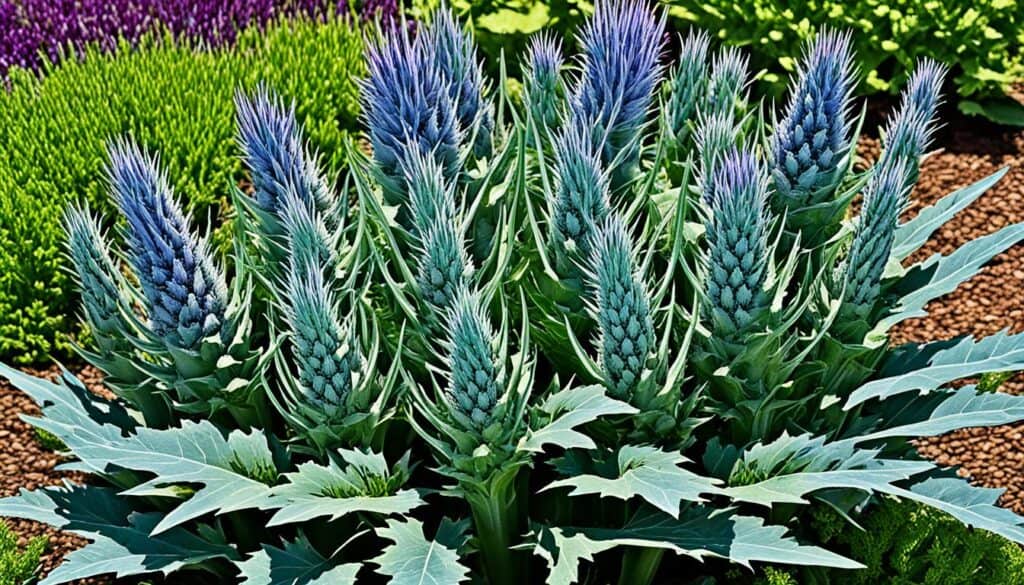
When it comes to cardoon plants, there are several varieties to choose from, including both spineless and spiny types. While the spineless varieties are preferred for cultivation, finding named cardoon varieties in U.S. seed catalogs can be a bit challenging. However, there are a few options available in certain catalogs that you can consider, such as ‘Tenderheart’ and ‘Gigante’.
If you’re looking for a wider selection of cardoon varieties, European catalogs might be a better choice. Some popular varieties in European catalogs include Bianco Ameliore, Italian Dwarf, Large Smooth, and White Improved.
These varieties offer different characteristics and can add diversity to your cardoon garden. If you’re up for a trial, especially in the Pacific Northwest region, these European varieties could be worth exploring.
| Variety | Description |
|---|---|
| Bianco Ameliore | A variety with white stems and a delicate flavor. |
| Italian Dwarf | A compact variety that is perfect for smaller gardens or containers. |
| Large Smooth | A tall variety with smooth leaves and a robust flavor. |
| White Improved | An improved variety with white stems and a milder taste. |
With these unique cardoon varieties, you can explore different flavors, sizes, and growing characteristics. Experimenting with a variety of cardoon types can make your gardening experience even more exciting and rewarding.
Climatic Requirements for Cardoon
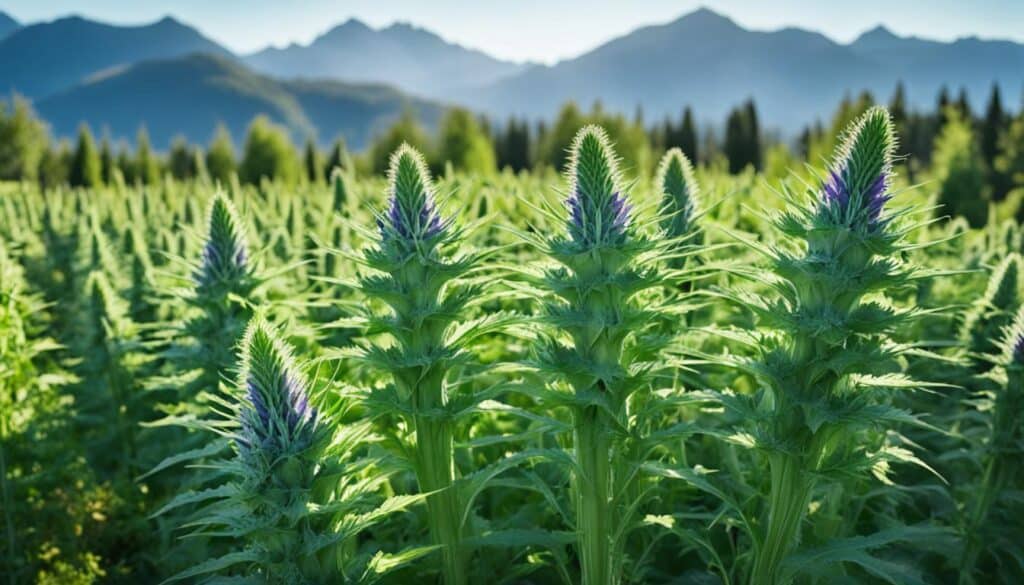
Growing cardoon plants successfully requires specific climatic conditions that support their optimal growth and development. Understanding these requirements is essential for cultivating healthy and productive cardoon plants. Let’s explore the key climatic factors that influence the growth of cardoon.
Frost-Free Coastal Areas with Cool, Foggy Summers
Cardoon plants thrive best in frost-free coastal areas with cool, foggy summers. These regions provide the ideal climate for the cultivation of cardoon plants. The moderate temperatures and coastal breezes create a favorable environment for their growth.
The temperate climate in these coastal regions helps prevent extreme temperature fluctuations, allowing cardoon plants to flourish. Cool and foggy summers provide relief from scorching heat, preventing the development of strong bitter compounds that can render the plants inedible.
Mild, Damp, Maritime Climate
Cardoons require a mild, damp, maritime climate to thrive. They prefer regions with moderate rainfall and humidity. The damp conditions provide the necessary moisture for the plants’ growth and help maintain their health.
Ideally, cardoon plants should be grown in regions where the average annual rainfall is around 20-30 inches, distributed uniformly throughout the year.
The maritime climate, influenced by the proximity to the ocean, contributes to the overall health and vigor of cardoon plants. The gentle coastal breezes and the consistent moisture in the air contribute to their optimal growth.
Optimal Height and Growth
Under the ideal climatic conditions, cardoon plants can reach a height of 3-5 feet. These vigorous plants display robust growth and thrive in the presence of the right amount of sunlight, moderate temperatures, and suitable moisture levels.
It’s important to note that cardoon plants may yield suboptimal results when grown under hot or arid conditions. Therefore, it’s crucial to select a location with the right climate to ensure the success of your cardoon cultivation.
| Climatic Requirements for Cardoon | Conditions |
|---|---|
| Temperature | Mild, cool, and frost-free |
| Rainfall | 20-30 inches per year, uniformly distributed |
| Humidity | Moderate, with a damp maritime influence |
By understanding and fulfilling the climatic requirements of cardoon plants, you can create an environment that promotes their healthy growth and ensures a bountiful harvest.
Seeding and Transplanting Cardoon
When it comes to growing cardoon, there are two primary methods: seeding and transplanting. Both approaches have their advantages and can yield successful results. Let’s take a closer look at each method.
Seeding Cardoon
Seeding cardoon is a popular option for many gardeners. To start, you’ll need cardoon seeds, and it’s best to sow them at a rate of approximately 700 per ounce. If you’re planning to grow cardoon on a larger scale, around 4-5 lbs of seed would be needed per acre.
The optimal time to sow cardoon seeds depends on your desired planting schedule. For transplanting in mid-May, it’s recommended to sow the seeds in the greenhouse in early or mid-March. Keep in mind that cardoon plants are sensitive to cold temperatures, so it’s crucial to protect them from frost during this period.
Transplanting Cardoon
Another approach to growing cardoon is through transplanting. This method involves starting the cardoon seeds indoors and then moving the young seedlings to their final outdoor location.
To begin, sow the cardoon seeds in the greenhouse in early or mid-March. This allows the seedlings to establish themselves before being transplanted. Timing is key, as you’ll want to transplant the seedlings in mid-May when the weather has warmed and any dangers of frost have passed.
Whether you choose to seed or transplant your cardoon plants, both methods can be successful with the right care and attention. Just remember to provide adequate protection from frost and monitor the plants for optimal growth.
Conclusion
Cardoon is a versatile and unique plant that offers not only an interesting addition to any garden but also a delicious and nutritious vegetable. With proper cardoon plant care and attention, cardoon plants can thrive and provide a bountiful harvest. Whether grown for culinary purposes or purely as an ornamental plant, cardoon is sure to add beauty and flavor to any outdoor space.
When growing cardoon, it’s important to provide the plant with full sun and moderate watering. Cardoon plants can be grown outdoors or in large containers, making them suitable for various garden setups. They require space to grow, and attention should be given to their soil preparation and planting techniques.
Aside from its aesthetic appeal, cardoon has a wide range of uses. Its young and tender parts, such as the leaf mid-ribs and immature flower stalks, are edible and can be used in various recipes. Cardoon is a popular ingredient in Mediterranean cuisine and can be baked, stewed, or sautéed to create delicious dishes. In addition, cardoon is known for its health benefits, as it is a good source of fiber, vitamins, and minerals.
So, whether you’re a gardening enthusiast or a food lover, consider growing cardoon in your garden. Explore the different varieties available and experiment with its culinary uses. With its unique flavor and nutrient-rich profile, cardoon is a true gem that adds both beauty and taste to the garden and the dining table. Start your cardoon-growing journey and enjoy the benefits it brings. Happy gardening!

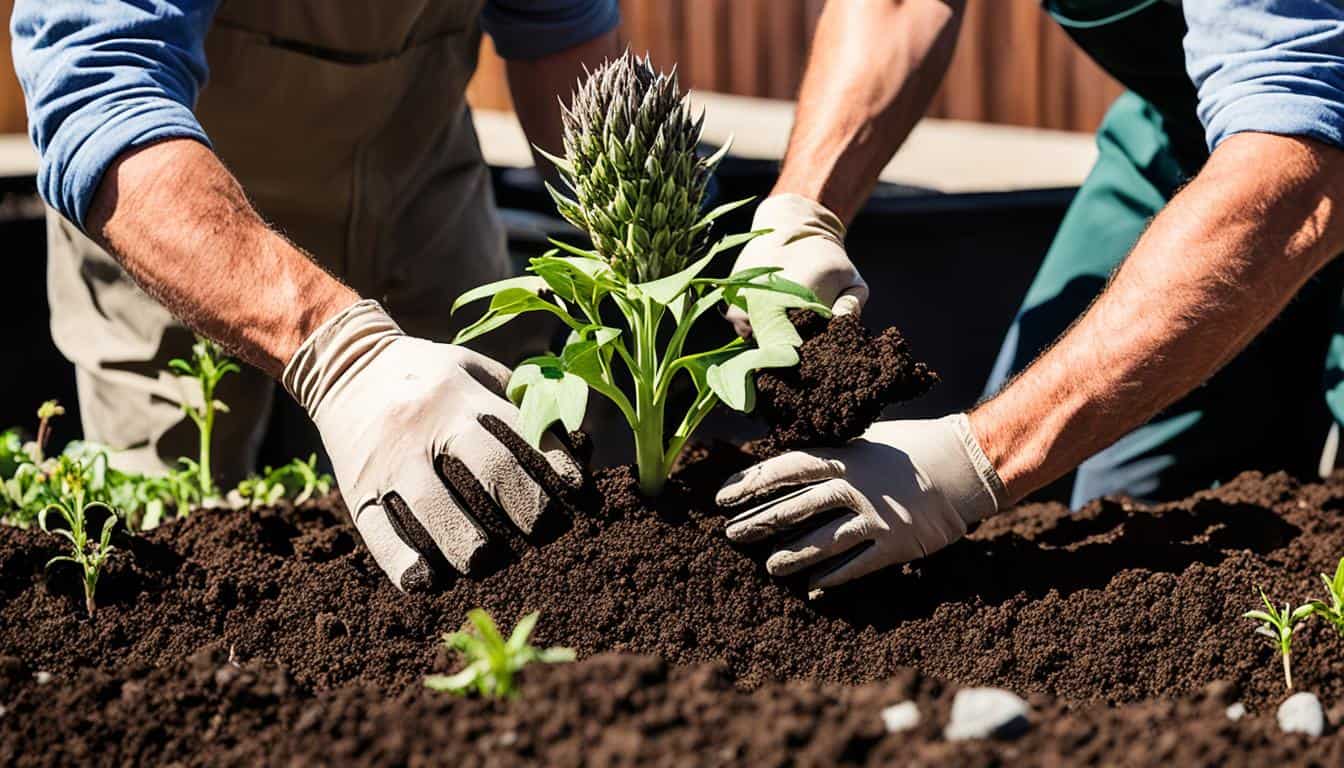



Leave a Reply